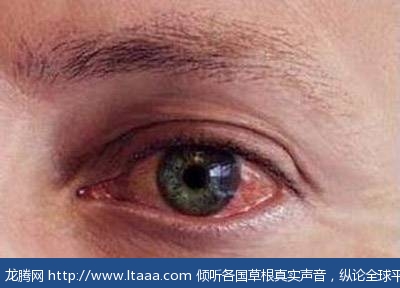研究表明,一直以来我们治疗红眼病的方式可能是错误的 [美国媒体]
如果你有红眼病,医生可能会给你开抗生素眼药水,然而这可能并不是正确的治疗方法。密歇根大学的一项最新研究表明,美国大约有60%的红眼病患者接受了上述对于红眼病的治疗,然而这种治疗往往是没有必要的。
You're probably treating your pinkeye wrong, study says
研究表明,一直以来我们治疗红眼病的方式可能是错误的
If you have pinkeye and a health care provider prescribes you an antibiotic eye drop, that might not be the correct treatment after all.
如果你有红眼病,医生可能会给你开抗生素眼药水,然而这可能并不是正确的治疗方法。
That's according to a new study out of the University of Michigan, which found that approximately 60 percent of patients across the country receive such prescriptions despite the fact they aren't typically necessary for treatment.
密歇根大学的一项最新研究表明,美国大约有60%的红眼病患者接受了上述对于红眼病的治疗,然而这种治疗往往是没有必要的。
What's more: 20 percent of those who filled these prescriptions got antibiotic-steroid eyedrops that could make the infection worse or last longer.
此外研究还发现,其中有20%的被开了该治疗方法的人,接受了抗生素类固醇眼药水的治疗,而这可能会使得症状加剧或持续更长时间。
The results are in line with a trend across the country of antibiotic misuse when it comes to treating common viral and mild bacterial illnesses.
该调查结果和全美国抗生素药物的滥用趋势相符,在治疗普通病毒性和轻微细菌性疾病的时候,人们普遍倾向于使用抗生素。
The study was published in Ophthalmology, the journal of the American Academy of Ophthalmology.
该项研究发表在隶属于美国眼科医学会的《眼科医学杂志》上发表。
There are three types of pinkeye: viral, bacterial and allergic conjunctivitis. Antibiotics can't fix viral infections or allergies, where most of the cases originate.
红眼病的类型一共有3种:病毒性、细菌性以及过敏性结膜炎。而抗生素是治不好病毒性感染和过敏引起的红眼病的,这也是很多滥用抗生素案例的来源。
The data for the study came from a large managed care network in the United States.
研究数据来源于美国政府的大型医疗网络。
Researchers found that of the 340,372 people who received an acute conjunctivitis (pinkeye) diagnosis across a 14-year span, 58 percent filled their antibiotic eyedrop prescription. Only a small amount of these people received a diagnosis from an ophthalmologist, with the others seeing the likes of a family medicine physician, pediatrician and others.
该研究发现,在14年中,其中340,372患者被诊断为急性结膜炎(红眼病),58%的人配了抗生素眼药水。其中只有一小部分人的诊断来自于眼科医生,而其他人问诊的则是家庭医生、儿科医生或其他医生。
"Filling antibiotic prescriptions seems to be driven more by sociodemographic factors and type of provider diagnosing the enrollee than by medical indication," according to the study.
研究表明:“配抗生素类药物更多的是受到社会人口因素以及诊断患者的医疗服务提供者的类型,而不是根据医学上的理由。”
For instance, those who wear contact lenses or who had diabetes or HIV/AIDS have a higher risk for such an infection.
比如,那些带隐形眼镜、或有糖尿病、或感染了艾滋病的患者有更高的风险感染红眼病。
In addition, there was a two or three times higher likelihood that people would fill antibiotic eyedrop prescriptions if a primary care or urgent care provider gave the diagnosis compared to an ophthalmologist.
此外,如果患者接受的是初步治疗或者急诊的话,那么被开抗生素眼药水的可能性要比眼科医生高2至3倍。
Why are they overprescribed? Authors point to school policies (i.e. kids not being allowed in school without treatment) and a lack of education among patients as reasons, not to mention that much about the causes are still unknown. Health care providers could also be prescribing antibiotics unnecessarily.
为什么患者会被乱开药呢?研究者认为是学校的政策(比如如果孩子不接受治疗的话是不允许进学校的)和患者间普遍缺乏相关教育有关,当然还有更多仍然不得而知的原因。提供医疗服务的人员也可能无谓地去开抗生素类药物。
"Educating patients about acute conjunctivitis' often benign, self-limited course may help to dispel misconceptions about the condition and reduce reflexive demands for immediate antibiotic use," Dr. Joshua Stein, study author, said in a statement.
该研究的作者,约书亚·斯坦因(Joshua Stein)在一份报告中说到:“需要让患者知道急性结膜炎的症状通常是良性的,告诉他们自限性过程(译者注:自限性是指通过自己的免疫系统工作,恢复机体功能并且不会造成慢性损伤),就可以让人意识到认识上的误区,降低一有什么病症就条件反射似地马上寻求抗生素药物的需求。”
In the United States alone, 6 million people get pinkeye every year.
仅在美国,每年就有6百万人患上红眼病。
版权声明
我们致力于传递世界各地老百姓最真实、最直接、最详尽的对中国的看法
【版权与免责声明】如发现内容存在版权问题,烦请提供相关信息发邮件,
我们将及时沟通与处理。本站内容除非来源注明五毛网,否则均为网友转载,涉及言论、版权与本站无关。
本文仅代表作者观点,不代表本站立场。
本文来自网络,如有侵权及时联系本网站。
图文文章RECOMMEND
热门文章HOT NEWS
-
1
Why do most people who have a positive view of China have been to ...
- 2
- 3
- 4
- 5
- 6
- 7
- 8
- 9
- 10
推荐文章HOT NEWS
-
1
Why do most people who have a positive view of China have been to ...
- 2
- 3
- 4
- 5
- 6
- 7
- 8
- 9
- 10











